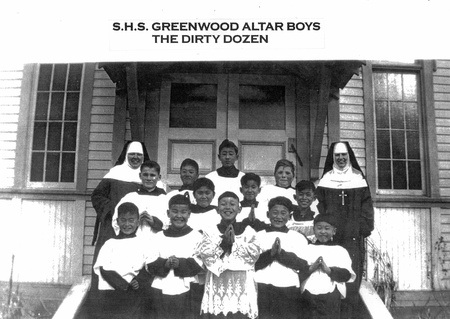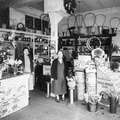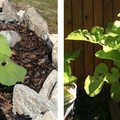When the saints go marching in, oh when the saints go marching in…. oh when the Nisei-nts go marching in…… There was Christian influence in Japan when missionaries had travelled there in the 1800s. Even before that Jesuit priests from Portugal were present. Tokugawa government tried to put a stop to Christianity. The recent movie Silence is based on that part of history. By the late 1800s, Christianity was viewed as modern and progressive. Therefore, when Japanese immigrants came pouring into British Columbia, there were several Japanese ministers already established.
Goro Kaburagi was a Methodist minister (1879), newspaper editor, and publisher on Powell Street in Vancouver. Reverend Kaburagi was asked to become the Japanese-speaking minister in 1896. In 1903, three lots were purchased at the corner of Jackson and Powell to build a church. United Church was dedicated in 1906. In 1907, Rev. Yoshi Ono took his place as Rev. Kaburagi lost his ministry due to philosophical differences.
In Victoria, B.C., according to Ann-Lee and Gordon Switzer’s book, Gateway to Promise, the first two ministers were Rev. Hirio Saijo and Rev. Koichi Inaka. By 1894, the Japanese mission was on Yates Street and officially established two years before Vancouver’s church was founded. Rev. Kaburagi also came to Victoria. Then, he was followed by Ukichi Oyama, Eiichi Kuwabara, A. Kato, M. Osawa, S. Nakanishi, and Y. Ogura. Kosaburo Shimizu arrived in 1918 and membership doubled. During the war years, he became very prominent in Kaslo during the internment years in B.C.
In Steveston, Reverend S. Kawabe from the U.S. came to conduct the first Christian service in Japanese. The Japanese Mission Church was founded in 1897. The church was located across from the Fishermen’s Hospital at No. 1 and Chatham Street.
In Vancouver, on Gore and Cordova Street, St. James Anglican Church and Kathleen O’Melia started to work with the Japanese in the early 1900s on Powell Street and she had some luck converting them to Christianity. She was known as O’Melia-san to the Japanese. However, Methodist had an older, larger mission on Jackson Street.
According to Jacqueline Gresko’s essay on O’Melia-san, Kathleen left the Anglican Order in 1912 soon after Rev. Clinton passed away. From there, she had a calling to convert to Catholicism. In 1926, Kathleen was ordained Sister Mary Stella at the age of fifty-seven. She started a Japanese Catholic Mission day-care nursery for working Japanese mothers, and kindergarten in 1929 to compete with the United and Anglican kindergarten programs. The goal was to teach children English before entering public elementary school. In 1931, Sr. Mary Stella and Sr. Antoinette went to Steveston and knocked on every cannery row house door to convert the Japanese to Catholicism. Sisters offered day care and English classes. Over 200 were converted. In 1932, Father Benedict Quigley and Fr. Pacifus Brown from the Franciscan Friars arrived to join the Sisters’ quest to conduct mass at the Japanese Catholic Mission. Sr. Mary Stella died in 1939 and she was unable to see her fruit of labour become a reality. Fr. Peter Baptist Katsuno was ordained in 1940. Sr. Mary Stella enjoyed her work and loved the Japanese Canadians.Most of the Christian missionaries played a vital role during the incarceration of Japanese Canadians after Japan attacked Pearl Harbor on December 7, 1941. The Franciscan Sisters and Friars had two Japanese Catholic Mission Houses, one in Vancouver and another in Steveston. Therefore, they were most instrumental in finding Greenwood to become the first internment site. While the provincial and federal governments were arguing who was to finance the education of Nikkei children, the Franciscan Order stepped in and established Sacred Heart School (SHS). Sacred Heart Church in Greenwood was already in place since the late 1800s. United Church of Greenwood had Miss Namba and Miss Madeleine Bock teaching Nikkei and local children kindergarten.
Nearly all Nikkei children attended SHS. Some United Church parents were able to get their children in the public school. Many Buddhist families also had their children at the Catholic school.
Those children who were already baptized in Vancouver and Steveston had no problem in school as they were familiar with catechism and the Catholic faith. Many children from the Buddhist families wanted to become Catholic. Thus, many were baptized at Sacred Heart Church. My mother was a staunch Buddhist, and her daughters were in tears that they wanted to be baptized Catholic. Mom chuckled in Japanese, “Oh well, if you are that adamant, go ahead.”
Sacred Heart School taught catechism and of course the students became very diligent in the religion. I remember seeing a page in the book with three milk bottles. One was pure white, the second bottle had speckled black spots, and the third bottle was all black! The black bottle was full of mortal sins. The spotted one had venial sins. Of course, the white bottle meant that you were free of sins. How powerful was that to a young primary child? There were some Buddhist parents who didn’t have their children baptized for one reason or another.
Those who became Catholic followed the faith diligently. Many boys became altar boys. Girls sang in the choir. The church was packed every Sunday.
Becoming an altar boy was quite a prestigious position for a young apprentice. By about grade five, one would become a full-fledged altar boy. He was proud to wear his black and white cassock, but to wear the red and white for special mass was another notch up. Usually, the red outfit was worn for High Mass on Christmas Eve. To the altar boys, it was called Midnight Mass. This was like having a leading role in the play. Amongst the boys, it was a test of boyhood to stay awake for the whole mass that late in the evening. The flow of incense was much heavier and the littlest boy had to hold this huge book on his forehead for the priest. The young altar boy was probably half asleep by then and the incense would make him sneeze. The book would start wavering as the boy tried to stay awake, but dozing off at times. The priest probably thought he had vertigo.
Holy Communion was the last part of the mass. The parishioners would line up and kneel all along the low railing. The priest placed the host on the tongue of the receiver. The altar boy chosen placed the brass plate below the chin so that the host would not drop to the floor. Those who came up had no sins since they said their confession. Some people had certain quirks in receiving the host. One lady would have her eyes wide open and the tongue sticking out at max. Another had a nervous twitch so her tongue would be shaking all over. The priest had to time it just right to get the host to stick to her tongue. This young girl, deliberately or not, would be cross-eyed. There was a blinking person as well. It was challenging for the altar boy to keep a serious face.
Children who were devout Catholics carried a rosary. Like the Lady of Fatima, the girls would go up in the hills to find a small cave or crevice and say their rosary, hoping to experience a miracle. The Blessed Virgin Mary might appear.
Young boys and girls took their religious statues that they made in summer school up in the hills and placed Jesus, Joseph, and Mary in a make-shift altar. They all said their ten Hail Mary and Our Father. After that, they had their picnic lunch.
One time, my older sister fell in the freezing water while skating. It was quite shallow. Some of the older boys pulled her out. Meanwhile, the little children were saying their Hail Mary so that she would survive.
The confession box was another thing. As a young child, it wasn’t quite as stressful. You said, “Bless me Father for I have sinned, this is one week since my last confession.” Then, the child proceeded to tell the priest his sins, “I lied five times, I disobeyed my parents two times, and I had a fight with my sister.”
As you got older, the confession might have sounded like this, “I looked at dirty pictures once, I lied two times, I stole candy from my friend….”
Being a teenager got more stressful. For a girl, it was tough. She might have had to wriggle around this to confess to the priest. “Bless me father for I have sinned…. my boyfriend took liberties with me, we did French Kiss, I swore 10 times and oh, I lied three times.” Little white lies?
For adults, I always wondered what they said in the confession box? One sin was: Thou Shalt Not Covet Thy Neighbour’s wife or husband. Who didn’t receive the holy communion that Sunday?
There were yancha children who didn’t quite follow the faith diligently. In church, one would pass gas and another would poke someone beside in the bum, and giggles became contagious. Sisters came to the front pew to reprimand the culprits and sent them outside to “cool” off.
Once, our dog Jockey came running down the aisle when a person who was late for mass opened the door. It was chaotic! My brother sent him out several times. Out of the blue, there would be a burst of laughter. Jockey was up on the lower roof looking through the stained-glass window! St. Jockey.
Church was a place of worship and it was very solemn, well not always. However, churches provided safety, education, and support during the ordeal of forced relocation. That we are forever grateful.
*This article was originally published on the Bulletin on April 2017.
© 2017 Chuck Tasaka








